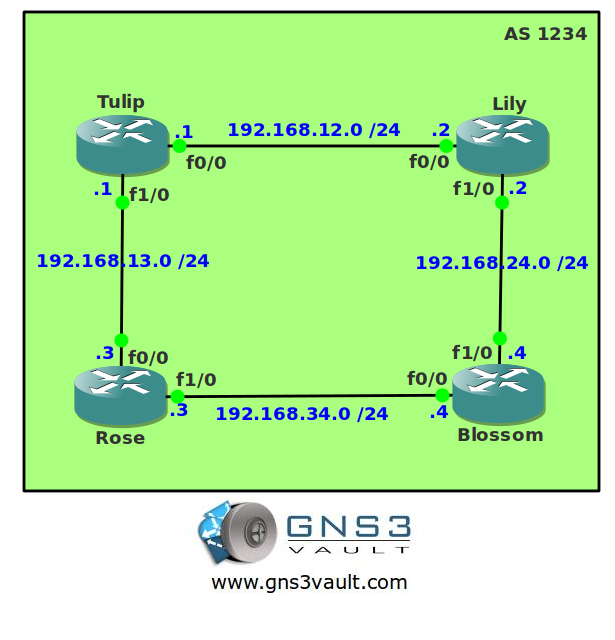Scenario:
Big Blooms is a fairly large retail company selling all kinds of flowers. Big Blooms has multiple sites and will use BGP in the future to connect all the different sites. Their headquarters network will be used to connect all the different networks and will be used as a transit for all the different sites. In order to prepare for the BGP configuration you have to configure IBGP (Internal BGP) for them.
Goal:
- All IP addresses have been preconfigured for you as specified in the topology picture.
- Each router has a loopback0 and loopback1 interface.
- Configure IBGP AS 1234 on all routers. You are not allowed to use IP addresses on the physical interfaces for the neighbor adjacency.
- Advertise the loopback1 interfaces in IBGP and ensure you have full connectivity within AS 1234.
It took me 1000s of hours reading books and doing labs, making mistakes over and over again until I mastered all the routing protocols for CCNP.
Would you like to be a master of routing too? In a short time without having to read 900 page books or google the answers to your questions and browsing through forums?
I collected all my knowledge and created a single ebook for you that has everything you need to know to become a master of routing.
You will learn all the secrets about BGP, the difference between IBGP and EBGP and more.
Does this sound interesting to you? Take a look here and let me show you how to Master CCNP ROUTE
IOS:
c3640-jk9o3s-mz.124-16.bin
Topology:

Video Solution:
Configuration Files
You need to register to download the GNS3 topology file. (Registration is free!)Once you are logged in you will find the configuration files right here.

The How to Master series helps you to understand complex topics like spanning-tree, VLANs, trunks, OSPF, EIGRP, BGP and more.
Written by René Molenaar - CCIE #41726


Good lab,
It really simplifies the fundamental difference between eBGP and iBGP on how routes are forwarded, i.e. eBGP loop prevention vs iBGP split horizon.
thanks
Marthin
Thanks Marthin. This lab is the key to understanding the "IBGP split horizon rule" 🙂
Quick question…
I thought with the BGP split horizon rule, if an iBGP router receives an update from another iBGP router, the iBGP router who received the update will not forward the update to it’s other iBGP neighbors unless you have a full mess, using route reflectors or confederations…?
If that is the case, why is that when I do this lab, all of my routers are learning the Loopback 1 IPs from the other routers?
Thanks in advance!
Let me clarify… This topology is almost a full mesh, but there isn’t a connection between Tulip and Blossom, so I am curious on why Tulip is learning routes about Blossom and vice versa since this an iBGP network.
Thanks for any insight !
The ethernet connections aren’t full mesh; the iBGP connections are full mesh. The routers could be physically attached via any topology and this would work the same.
Unlike eBGP which will only work on directly connected routes unless you explicitly configure it for multihop operation, iBGP will work so long as the neighbor is reachable over a route more specific than the default route.
So since the routes between Tulip and Blossom’s loopback interfaces are known to each other from the IGP, they can establish iBGP session no problem.
That’s exactly the answer. IBGP routers don’t have to directly connected but they do have to be configured as a full-mesh. By running an IGP within the autonomous system the IBGP routers will be able to reach each other.
really good lab, hammers home the point about ibgp split horizon, also hammers home the point of full mess requirement.
thanks again rene
great job
Hello Rene,
In IBGP – INTERNAL BGP Topology, I just tried shutting down the interface f 0/0 at at Tulip router and its a full mesh topology. But BGP table at R1 was still receiving the 22.22.22.0 network. NO Next-Hop-Self is implemented. So how does this can happen.? According to IBGP split horizon rule, Neither Rose or Blossom can not advertise the updates which is received from Lilly. So my question is Even though interface f 0/0 in Tulip is down will neighbor-ship is formed between Tulip and Lilly and will there be any advertisements made between them..
Waiting for the response.
Regards
Vivek
Aweome lab. Explains the BGP Loop prevention concepts clearly
@ Viveck88,
the reason is , even though you shut down Tulip’s F0/0 interface you can still reach router Lily using IGP via 192.168.13.3 (via Rose ). And since your IBGP neighbor with Lily has been established with Lily’s loopback 0 interface (2.2.2.2) which is still reachable, hence the iBGP neighbor relationship between Tulip and Lily will still be up. hope my explanation help?
Hi Rene, Thank you for all the labs and video.
I m just learning about BGP and can’t see whats the purpose of having OSPF running in background with internal BGP. My logical brain is telling me, Internal BGP is fully meshed. Why would you need another protocol like OSPF?
Thanks in advance
MM
How can two iBGP routers peer if they lack IP reachability to one another? Imagine 3 routers in a line and you want to fully mesh them with iBGP.
Just notice that when you trace route from Tulip to Blossom, you get load balance between Lily and Rose as both links have the same OSPF metric. What I did was to specify bandwidth as 1 Mbps in one of the links at Rose to improve the metric on the other side. (Just as complement to the lab)
good lab… good comment by Alfonso Meneses.
Excellent lab, thanks !